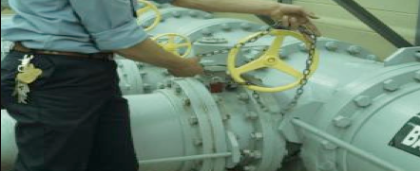Spot The Safety Violation: Which Lockout Is Correct?

Photo A:

Photo B:

Only one of these photos shows machinery that’s been properly locked out’can you tell which one’
Machinery and equipment pose serious safety hazards to the workers who operate them. For example, they must be powered down and locked out before workers do maintenance or repair work on them.
Both pictures show machinery that’s supposedly been locked out. But only the equipment in Photo A has been properly locked out:
- The machinery is effectively isolated from the power source so it’s impossible to operate the equipment without removing the two locks.
- There’s also a tag is in place to notify workers that the equipment is locked out and that the locks may be removed only by the authorized person who placed them.
In contrast, Photo B depicts an improper lockout. Although the valves are wrapped with a locked chain, they can still be operated. In other words, the chain doesn’t effectively lock out the machinery and so does nothing to protect workers who may work on it.
Why is proper lockout so important’ Because without it, workers can get seriously injured and even killed if machinery starts up while they’re fixing or cleaning it.
Example: A worker noticed that slats underneath a conveyor belt were out of position. So he lifted the belt with one hand and began to pound the slats back into place with the other. But he didn’t lock out the conveyor belt. A co-worker pressed the start button and the conveyor belt began to move, pulling the worker’s hand into a sprocket. He sustained a broken finger and required a significant number of stitches. Although the worker had been trained on guarding and lock-out procedures in general, he wasn’t trained on locking out this conveyor belt. The manufacturer pleaded guilty to an OHS violation and was fined $40,000 [Cargill Limited-Cargill Limite, Ontario Govt. News Release, April 17, 2014].
8 KEYS TO PROPER LOCKOUT
Here are eight key things you need to know to ensure that you comply with the lockout requirements in your jurisdiction’s OHS laws:
1. Which machinery and equipment is subject to the lockout requirements
2. When the OHS laws require such machinery to be locked out, such as when a guard is removed from machinery or equipment or when workers are troubleshooting the equipment (use this lockout hazard identification and risk assessment worksheet)
3. Any exceptions to the lockout requirements, such as when the machinery must be running so workers can figure out what the problem is
4. What group lockout is and when it’s appropriate
5. The requirements for the locks used in lockout procedures, including identifying which locks have been assigned to which workers
6. The requirements for lockout tags, if applicable
7. Why you should have a lockout policy and procedures and what they should cover, such as the procedures for when a supervisor must remove a worker’s lock
8. What lockout training for workers should include.